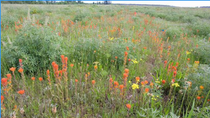

Why Native Plants?
Short video with Doug Tallamy. (3:58 minutes video) #Biodiversity #Insects #Native Plants #Habitat #Prairie #Wildflowers #Restoration


BioBlitz at Rasor Park with Rick Ahrens
BioBlitz at Rasor Park with guides Rick Ahrens, Becky Riley, James Hershiser Sunday, April 28, 1-5 PM 1-2 PM Trees, Shrubs, Wildflowers...
City of Eugene Native Plant Alternatives
(6 page PDF document) Native Plant Alternatives. There are many beautiful native species that are readily available from local native plant nurseries. Below is a list of some of the more common species that are found in the southern Willamette Valley. While native species generally require less water and care than non-native species, this is only true when planted in the appropriate soil moisture and sunlight conditions. We have tried to include brief notes on habitat requir
Western Oregon Prairies
(2 page brochure) What are prairies?; Animals and plants of upland prairies; Are prairies in trouble?; How can you help? Native prairies are a severely endangered habitat in Western Oregon... Oregon State University and US Fish and Wildlife Service. Western Oregon Prairies


Native Herbaceous Plants in Our Gardens: A Guide for the Willamette Valley
(40-page booklet) Excerpts from Native Herbaceous Plants In Our Gardens: "Growing native herbaceous plants in our gardens may preserve or re-introduce many of the diverse plants that weave natural tapestries across the Willamette Valley. Herbaceous plants are annuals and perennials that lack woody stems; they include bulbs, grasses, sedges, rushes, evergreen and deciduous ferns, and broad-leaved flowering plants. Historically, these native plants thrived in the Willamette V






















